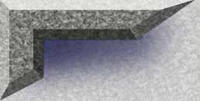The African violet really is an African plant. While it presumably grew uncelebrated by botanists and plant-lovers for countless millennia it had to wait until 1892 for its official discovery by the Baron Walter von Saint Paul, the German governor of a northeastern province in Tanganyika, now part of Tanzania.
Von Saint Paul found the plant growing among shaded rocky ledges in the Usambara Mountains. He immediately sent seeds of his "Usambara violet" to his father in Germany. In Germany the plant acquired a botanical name which it still bears today: Saintpaulia. Other species closely related to this first were soon discovered. They all bear the genus name Saintpaulia plus an adjective describing the individual species.
The original plant discovered by Walter von Saint Paul is Saintpaulia ionantha. There are more than twenty other similar but certainly not identical species in the genus. They have memorable names betraying what those naming them thought of them such as: Saintpaulia difficilis, S. confusa, S. inconspicua. Others have adjectival names indicating place of origin: S. magungensis, S. teitensis, S. tongwensis. Magunga, Teita, and Tongwe are all place names associated with Tanzania.
The African violet enjoyed some success as a houseplant in Germany and other European countries and was brought to this continent by the California firm of Armacost and Royston in 1926 when they imported seeds from the German and British greenhouses that had specialized in the plant; The varieties that Armacost and Royston grew from these first batches of seed are still often grown today. All were basic blue in bloom colour and the bloom type was the standard single, pansy-shaped blossom we associate with African violets. Sometimes the foliage is multi-crowned or trailing as the species have a variety of growth habits.
Not all African violets today have the pansy-shaped, blue blossoms that led to the popular name of the plant. Hybridizers' efforts over the past many decades have succeeded in bringing us new plant sizes and growth habits, blossom colours, and many other changes which add enormous variety to a collection of African violets.
Taking Care of your African Violet
Just as almost everyone likes to practise good care of himself or herself with proper food, sleep, etc., so a good plant grower provides good care to his or her plants. This basic care creates a healthy, contented individual and a healthy, contented plant. There is always someone on the block who does a little extra in the way of grooming who then radiates his/her good health and contentment better than the average. An African violet grown by a good groomer will look bettter than an equally healthy plant grown by someone more casual. Grooming is not complex and well worth the few extra moments.
Alwaysremove dead or dying foliage and flowers. Watch that outer row of leaves. These leaves start to fade long before they die and removing faded outer rows gives a better looking plant. Old outer rows are often smaller than the next row in and upset the proportions of the plant. Also remove suckers, those tiny plantlets that sometimes appear in the leaf axils, as soon as they are big enough to handle. As they grow they distort the plant's symmetry. You can often use the sucker as propagating material. If a leaf is growing out of position, gently move it to its proper place and hold it there with small stakes until it shows signs of staying there. Rotate your plants one quarter turn at least each time you water. Some even do this daily. Plants that stay stationary lean towards the light source.
Keep your plants free of dust and soil particles. Household dust settles on the leaves as it does on your coffee table. You likely know what the coffee table would look like if you did not dust it. The common tool for dusting is a soft, natural bristle brush such as a pig bristle pastry brush or a sable hair artist's brush. Never use a brush with artificial bristles. Even the softest artificial bristles have blunt ends which can injure the leaf surface. Gently stroke dust or spilt soil off the leaves.

